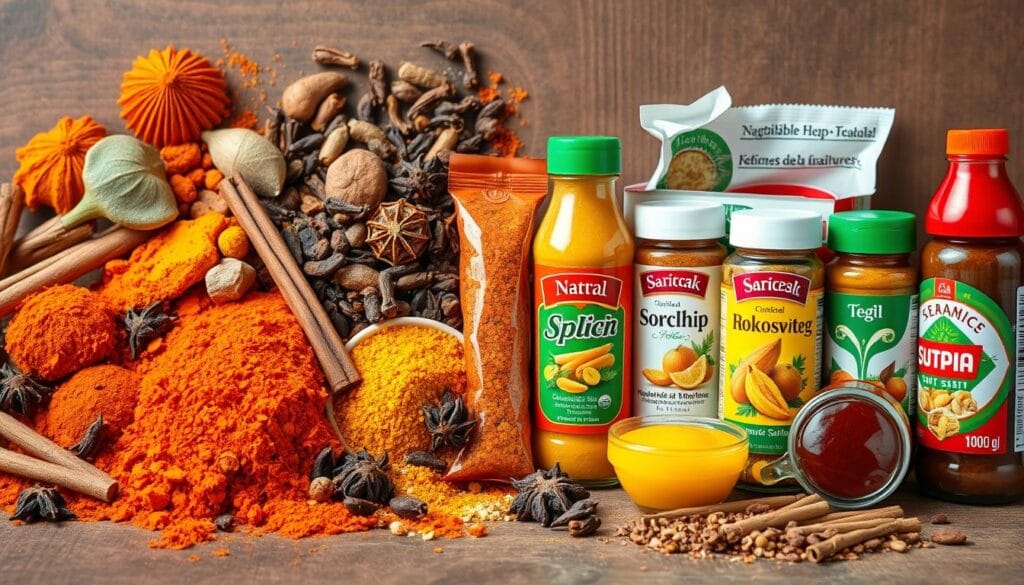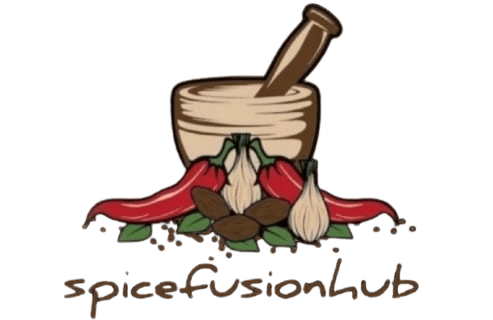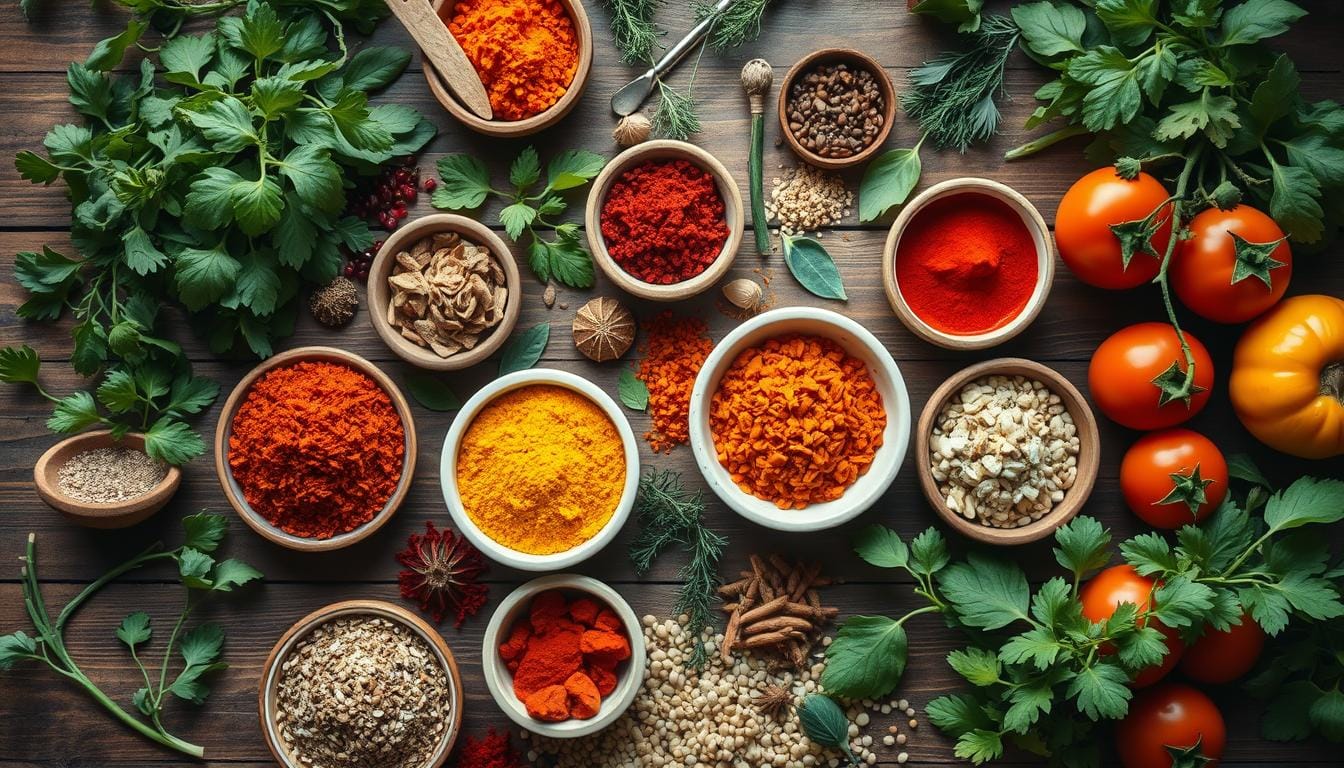Healthy Eating with Spices
Have you ever thought about how a simple sprinkle of spices can change your meals? It’s not just about making food taste better. It’s about using these powerful ingredients to make your meals both tasty and healthy. Spices have been a key part of cooking for centuries, adding excitement and health benefits to our food.
In this section, we’ll show you how spices can help you eat healthier. We’ll also get you ready to explore more about spice-infused dishes that are both delicious and nutritious.
Key Takeaways
- Spices can enhance the flavor of your meals while providing health benefits.
- Integrating spices into your diet helps create flavorful and healthy recipes.
- Spices have been celebrated for centuries for their nutritional value.
- Healthy Eating with Spices promotes overall well-being.
- Adding spices to your cooking can lead to creative and diverse dishes.
Understanding the Benefits of Spices in Your Diet
Adding spices to your meals can make them taste better and be healthier. Spices do more than just add flavor; they also bring nutritional benefits. Learning about these benefits can help you see how spices can improve your diet.
Nutritional Advantages of Common Spices
Many spices are packed with nutrients. Garlic, for example, is not just tasty but also full of antioxidants that help your heart. Ginger is known for fighting nausea and boosting overall health. Adding these spices to your meals can make them more nutritious and support your immune system.
| Spice | Nutritional Benefit |
|---|---|
| Garlic | Supports heart health and has antioxidant properties |
| Ginger | Reduces nausea and promotes digestive health |
| Cinnamon | Helps regulate blood sugar levels |
| Tumeric | Reduces inflammation |
How Spices Support Digestive Health
Spices can help with digestive issues. Peppermint soothes the stomach, while fennel can reduce bloating and improve digestion. Using spices regularly can make your food taste better and help your digestive system stay healthy. For more on the benefits of spices, check out this link.
Top Spices for Enhancing Flavor
Spices are key to making meals special. Turmeric and cinnamon are great choices. They add flavor and health benefits. Using these spices can make your cooking better and healthier.
Turmeric: The Golden Spice
Turmeric is known for its bright yellow color and health benefits. It has an earthy taste that goes well in many dishes. You can add it to stews or rice for a tasty and healthy touch.
Cinnamon: Sweetness with Health Benefits
Cinnamon makes dishes sweet and savory. It’s good for your health too. Use it on oatmeal, in smoothie bowls, or as a meat rub. It’s a spice that makes food delicious and healthy.
Incorporating Spices into Everyday Meals
Adding spices to your cooking can make simple meals special and healthy. Learning about seasoning and mixing spices can really improve your dishes.
Tips for Seasoning Basics
Start with a few key rules when adding spices. It’s important to balance flavors. For example, light spices like basil go well with light proteins. Strong spices like cumin are great with beef or veggies.
Here are some tips:
- Start with a little spice and adjust as needed.
- Heat spices in a skillet to bring out their taste before adding to food.
- Add spices at different stages of cooking for better flavor.
Spice Blends: Quick Flavor Boosts
Making your own spice blends can make cooking quicker and tastier. These mixes add flavor fast and let you get creative. For example, a mix of garlic powder, onion powder, and paprika is good for meats and veggies.
Here are some healthy spice mixes:
| Spice Blend | Ingredients | Best Uses |
|---|---|---|
| Taco Seasoning | Cumin, chili powder, paprika, garlic powder, oregano | Meats, beans, and tacos |
| Italian Seasoning | Basil, oregano, thyme, rosemary | Pasta sauces, soups, and roasted veggies |
| Curry Powder | Coriander, cumin, turmeric, ginger, chili | Curries, stews, and rice |
For more tips on using spices, check this resource. Try these blends and adjust them to your taste for tasty, healthy meals.

The Role of Spices in Weight Management
Adding spices to your meals does more than just add flavor. They can also help with weight management. Many spices have special properties that aid in weight loss. This makes them key players in reaching health goals.
Spices do more than just taste good. They help control hunger and boost metabolism. This is especially true for managing appetite and increasing metabolism.
Spices that May Help Curb Appetite
Some spices can help reduce hunger and make you feel full. Cayenne pepper, for instance, has capsaicin. This has been shown to cut down on appetite and make you feel more satisfied.
Ginger also has benefits for metabolism and can curb cravings. It’s a spice that can help with weight management. Adding these spices to your meals can support your weight loss journey.
Metabolism-Boosting Ingredients
Spices can also boost metabolism, aiding in weight loss. Cinnamon is a powerful spice that adds flavor and may improve insulin sensitivity. It helps regulate blood sugar levels, leading to less fat storage and a more efficient metabolism.
Knowing the benefits of spices like cinnamon and cayenne pepper can guide your diet. It helps make better choices for your health.
| Spice | Appetite Control | Metabolism Enhancement |
|---|---|---|
| Cayenne Pepper | Yes | Moderate |
| Ginger | Yes | High |
| Cinnamon | No | High |
| Turmeric | No | Moderate |
By adding these spices to your meals, you can boost your weight management efforts. Spices offer a simple way to enhance taste and health benefits.
Exploring Global Spices for Healthy Eating
Spices are key to adding flavor and making meals healthier. They bring unique tastes and health benefits from around the world. Adding spices from different places can make food better and improve your health.
Herbs and Spices from the Mediterranean
The Mediterranean is known for its herbs and spices. They are full of flavor and good for your health. Here are some important ones:
- Oregano: It’s full of antioxidants and boosts your immune system. It also makes food taste great.
- Basil: This herb is not only tasty but also fights inflammation and bacteria.
- Rosemary: It smells amazing and helps with digestion and brain function.
Asian Spices to Try
Asian spices are exciting and healthy. They add flavor and offer health benefits. Here are some to try:
- Cumin: Common in Indian food, it helps with digestion and has antioxidants.
- Star Anise: It has a unique taste and helps with digestion. It might also fight off germs.
- Turmeric: Found in many Asian dishes, it’s known for reducing inflammation and has health benefits.
| Spice | Origin | Benefits |
|---|---|---|
| Oregano | Mediterranean | Antioxidant properties, immune support |
| Basil | Mediterranean | Anti-inflammatory, antibacterial |
| Cumin | Asian | Aids digestion, antioxidant |
| Star Anise | Asian | Promotes digestion, antimicrobial |
Adding these global spices to your meals can make food more interesting. It also brings health benefits. This shows how important spices are for a balanced diet.
Spices vs. Processed Flavorings: A Comparison
Choosing between spices and processed flavorings can greatly affect your cooking and health. Natural spices bring a wide range of flavors and health benefits. They are better than common condiments. On the other hand, processed flavorings have artificial ingredients and preservatives, which are not good for health.
Healthier Alternatives to Common Condiments
Many popular condiments like ketchup, salad dressings, and mayonnaise have a lot of sugar, sodium, and unhealthy fats. Spices, however, add flavor and health benefits. For example:
- Ginger: Helps with digestion and has anti-inflammatory properties.
- Garlic: May lower blood pressure and cholesterol levels.
- Cayenne Pepper: Increases metabolism and can reduce cravings.
Spices also add important vitamins and minerals to your meals, making them nutritious.
Cost-Effectiveness of Using Spices
In today’s world, saving money is important when planning meals. Spices are often cheaper than processed flavorings. A little spice can change a whole dish, cutting down on the need for expensive condiments. Here’s a cost comparison:
| Item | Cost per Ounce | Usage per Meal | Total Cost for 5 Meals |
|---|---|---|---|
| Spices (e.g., cumin) | $2.00 | 0.1 oz | $1.00 |
| Ketchup | $0.75 | 0.5 oz | $1.88 |
| Salad Dressing | $3.00 | 2 oz | $30.00 |
The table shows that using spices can save a lot of money while making meals more flavorful. This proves the benefits of spices over processed flavorings.

Cooking Techniques that Highlight Spices
Learn how certain cooking methods can make spices shine in your dishes. Mastering these techniques lets you cook with healthy spices, turning simple meals into something special. Roasting and infusing oils are two key methods for boosting flavors.
Roasting: Enhancing Flavor Profiles
Roasting vegetables or meats caramelizes their sugars, deepening their taste. This method also brings out spices, making them more aromatic. Here’s how to do it:
- Select your vegetables or meats.
- Preheat your oven to 400°F (200°C).
- Coat your ingredients in olive oil and your choice of spices.
- Spread them on a baking sheet in a single layer.
- Roast for 20-30 minutes, turning halfway through, until golden brown and tender.
Infusing Oils with Spices
Infusing oils with spices adds a burst of flavor to any dish. It’s great for sauces, dressings, and marinades. Here’s how to make your own infused oil:
- Choose your base oil, such as olive or canola oil.
- Add selected spices, like garlic, rosemary, or chili flakes, to a saucepan.
- Warm the mixture over low heat for 10-15 minutes, ensuring it doesn’t boil.
- Allow the oil to cool and strain it into a bottle.
- Use the infused oil for drizzling, frying, or dressing your favorite dishes.
Using roasting and infusing oils can make your meals more flavorful. These techniques help you enjoy the benefits of cooking with healthy spices. Try them out and see the delicious results.
Using Spices for Specific Health Goals
Adding spices to your meals can boost your health. Certain spices can fight inflammation and support your heart. Knowing which spices to use can help you make better food choices. We’ll look at anti-inflammatory spices and heart-healthy options, along with tips for using them in your cooking.
Anti-Inflammatory Spices
Many spices are great for fighting inflammation. They’re perfect for anyone looking to eat healthier. Here are some top choices:
- Turmeric – It’s packed with curcumin, a powerful anti-inflammatory.
- Cinnamon – This spice is full of antioxidants, helping fight oxidative stress.
- Ginger – Known for its digestive benefits, ginger also fights inflammation well.
Adding these spices to smoothies, soups, and teas can make them much healthier.
Spices for Heart Health
Some spices are good for your heart too. They can help keep your heart in top shape. Here are some heart-friendly spices:
- Garlic – It helps lower cholesterol, which is good for your heart.
- Paprika – Full of antioxidants, paprika helps keep blood flowing well.
- Cardamom – This spice can help lower blood pressure and improve heart function.
Try adding garlic to stir-fries or paprika to roasted meats for better heart health.
| Spice | Health Benefit | Usage Tips |
|---|---|---|
| Turmeric | Anti-inflammatory | Add to smoothies or curries |
| Cinnamon | Reduces oxidative stress | Sprinkle on oatmeal or yogurt |
| Garlic | Cholesterol management | Incorporate into dressings or sauces |
| Paprika | Promotes circulation | Use as a seasoning for roasted foods |
| Ginger | Supports digestion | Add to teas or stir-fries |
Using these spices in your cooking can greatly improve your health.
Creating Your Own Spice Mixes at Home
Making your own spice blends can make your meals taste better. It also lets you try out new spice mixes. With a few basic ingredients, you can make tasty DIY spice blends that fit your taste. For example, mixing paprika, cumin, garlic powder, and cayenne makes a great taco seasoning. A mix of basil, oregano, thyme, and parsley creates a wonderful Italian herb blend.
Simple Recipes for DIY Spice Blends
Starting with spice mixes is easy. A simple chili powder blend is chili powder, cumin, and garlic powder in equal parts. It’s great for many dishes. Another easy mix is curry powder, made from turmeric, coriander, cumin, and black pepper. Learning about basic flavors and ratios opens up a world of possibilities for your DIY spice blends.
Storing and Preserving Spices for Freshness
Keeping your homemade spice blends fresh is key. Store them in airtight containers in a cool, dark place. Avoid moisture and sunlight. Labeling jars with the date helps you enjoy your spice blends at their best. This way, every time you cook, you’ll get to enjoy the full flavor of your DIY creations.







